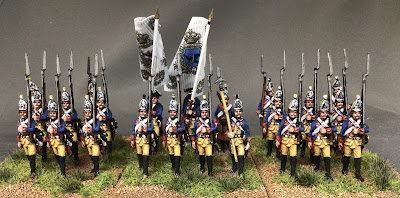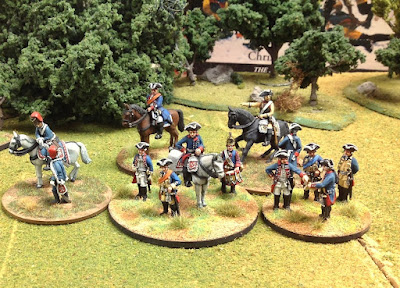 |
Newly painted third battalion of the Prussian Guards, wearing mitre hats.
The second battalion wore tricorn hats. |
CLICK OR DOUBLE CLICK ON ALL PICTURES TO ENLARGE
Yesterday I finished painting a 42-figure unit of the 15/III third battalion of the Prussian Guards for my Seven Years War army. The unit had been sitting on the painting table for several months now and I just couldn't find the gumption to finish them off. So I decided that enough was enough and it was time to finally get them finished and on the game table.
 |
| Front view of the Guards unit. |
 |
| Rear view of the Guards. The officers and NCOs form a third rank to the line. |
I had previously painted the second battalion of the Guards - they wore tricorn hats whilst the third battalion wore grenadier miters. The first battalion was the ceremonial guard unit that only saw action at the Battle of Kolin during the Seven Years War. The second and third battalions saw a lot of action over the course of the war. All of the figures, both second and third battalions, are Minden Miniatures figures that are specifically sculpted to the uniform details of the guards battalions.
I really had to power through the project at first, but eventually momentum kicked in and I started to make progress on the final 20 figures that I needed. The early stages of my painting method gets very tedious, especially when it comes around to painting all of the black bits on the figure. Here is step by step list of how I paint my figures:
1. prime the figures with a light grey color of spray primer. The Vallejo "Wolf Grey" is my favorite.
2. paint the skin areas an undercoating of red brown
3. paint the uniform coat a dark navy blue
4. paint the small clothes next (waistcoat and breeches) a dark yellow
5. paint the red facings (cuffs, lapels, turnbacks and collars)
Now comes the hard part, painting the equipment a black undercoat
6. paint black to all of the equipment such as cross belts, bread bags, knap sacks, water bottles, muskets, scabbards, gaitors, and headgear. This stage takes about 5 minutes per figure, but it becomes extremely tedious after the first couple of figures. I use black as an undercoat for anything that I paint brown or white.
At this point, most of the major colors are "blocked in" and cover the entire figure with various paint colors. Now I advance to applying highlights and details such as buttons and facial features .
7. paint a tan skin or ruddy flesh color over the red brown skin areas, leaving the red brown undercoat showing in the eye sockets and mustache.
8. paint the knapsack and musket dark brown.
9. block in the cross belts and bread bag with a light grey color
10. apply highlight colors on the blue coat, red facings and yellow small clothes.
11. apply white to the cross belts and bread bag.
12. paint the mitre plate on the grenadier mitre silver, paint the cartridge box emblem silver and paint the buttons and lace silver. Anything that has a metallic color must always have a black undercoat in order to make the metallic color be noticeable and have a "pop".
13. paint the musket barrel and water bottle a pewter color. I really do not like painting musket barrels and bayonets for some reason, so this stage is rather tedious for me.
14. paint the buckles, musket butt, sword hilts and scabbard tips Old Gold or brass.
15. (optional) paint all of the leg gaitor buttons with the Old Gold color. Again, this is a tedious step.
16. Add a skin color highlight, touching a small dot on the chin, bridge of the nose and cheeks. Hands get two stripes of highlight on the broad part of the hand. I generally do not paint knuckles. That is borderline ridiculous.
17. (optional) add another highlight red color. This is generally not necessary but it sometimes provides a color "pop" to the lapels.
18. paint the base dark green
The figure is finished at this point. Note that I do not paint eyes anymore, other than to put a black dot in the eye socket sometimes, nor do I highlight anything that I've painted black. I mean, black is black and it doesn't really lend itself to highlighting. My one exception to the "no black highlighting" rule is horse manes/tails and black horses. I mix a bit of flesh color to a basic black which produces a very dark grey color, which I use sparingly.
And that's how I paint my wargame figures. Once I have passed Step 12 then things seem to speed up and the feeling of tedium passes. I like painting the details on my figures because these seem to bring the figures alive.
Once all of the painting is completed then I move on to basing the figures. I use either MDF bases or buy thin plywood bases from Litko Bases. I glue the figures to the wood using white "Elmer's Glue" and let the glue dry overnight.
Next, I trowel in the "mud", which is a goop made of premixed wallboard paste (get the light paste and not the heavy paste - you can tell the difference just by picking up the quart container by hand). I like the Red Devil Pre-mixed Spackle Compound brand the best. I stir in a dark brown acrylic paint to the Spackle and stir it up until all of the white Spackle color is gone, with the final mix looking like chocolate pudding (but don't eat it!). I use a tiny artists' palette knife or scalpel to trowel the goop between the figures. Sometimes a toothpick or an old paint brush are used to get the goop between the feet of the figures.
While the goop is still wet, I dunk the base into a tray of extra fine railroad ballast made by Woodland Scenics. Then I let the base dry over night.
The next day I stir up some highlight colors and dry brush the paint over the bases. I might use two or three different highlight colors until I get something that looks right to my eye.
Now comes the foliage. I glue on pieces of tufts, which are long clumps of grass. Army Painter makes a nice variety of tuft colors. I use Swamp Grass tufts for the most part. I let the white glue dry for about an hour and then add static grass to the base. Let the tufts dry before you glue on the static grass, otherwise some of the static grass will adhere to the glue on the tufts and, well you won't like how that looks so it's better to let the tufts dry for a short while. You can also add flowers tufts and bits of ground clutter at this stage, if you like.
Now I paint white glue randomly on the base of the figures and dip the base into a tray of static grass, or I sprinkle the static grass onto the base. Then I turn the base sideways and tap the back of the base to remove excess static grass. Then I blow on the top of the base to make the static grass stand up.
The bases are now finished and the final step is to give everything a spritz spray of matte finish (Dull Kote or similar brands). Actually, oftentimes I spray the figures before I start adding the goop to the bases. One note of caution - if you are using GMB Designs flags or similar brands of pre-printed flags, I'd recommend spraying the flag bearer(s) separately, then all of the other figures get sprayed, and then you glue your flags to the flag poles. Then you glue the figures to the bases and then trowel on the goop. Some people like to spray the matte finish to the grassed bases but I don't find this to be a necessary step. Do be careful though to NOT SPRAY YOUR FLAGS with matte or gloss spray because the sprays make the ink colors run.
With the completion of the third battalion of the guards I now have seven units for my War of Austrian Succession Prussian army consisting of the following units:
IR1 Winterfeldt musketeers - 2 battalions
IR18 Prinz von Preussen musketeers - 2 battalions
IR15/II second battalion of the Guards - 1 battalion
IR15/III third battalion of the Guards - 1 battalion
Bornstadt Grenadier Battalion (5/20) - battalion
Plus the 36-figure Bayreuth Dragoons in white coats cavalry regiment.
Next on the painting table: Austrian Grenadier Battalion with 32 to 36 figures.






















































